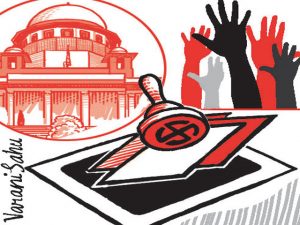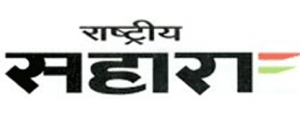
03-01-2017 (Important News Clippings)
To Download Click Here
Clean Bowled
Supreme Court cracks the whip against reform-resisting BCCI leadership

The latter, it will be recalled, was appointed by the apex court in 2015 to reform BCCI functioning. But although the recommendations of the committee had been approved by the court in July last year, BCCI has kept stonewalling their full implementation. It objected to the recommendation of having representatives of the players’ association on the board’s apex council, it resisted the one-state-one-vote formula, opposed tenure caps and 70 years age limit for office bearers, and even questioned the locus standi of the apex court to reform the cricketing body.
It also became apparent that BCCI was using funding as a tool to get state associations to resist the reforms. This is precisely why the apex court passed an interim order last October that no money was to be given to state associations unless they passed a resolution to implement the Lodha reforms. If this weren’t enough, there’s prima facie evidence that BCCI president Thakur had tried to get the International Cricket Council to dub the Lodha reforms as government interference. His denial regarding this in an affidavit is now being treated by the apex court as a potential case of perjury and contempt of court.
BCCI has been desperately trying to hold on to its monopoly over Indian cricket, citing technicalities and excuses for this. It was only a matter of time before the axe came down on the board. Hopefully, the apex court’s latest decision will provide the spark needed to dismantle the vested interests that have governed Indian cricket for far too long. That said, care needs to be taken to ensure that the churnings in cricket administration don’t hamper the sport itself. With an Indian cricket team on the ascendant, players and matches must not be adversely affected in the coming season
Date: 03-01-17
Is MGNREGA destroying factory jobs? Disquieting data shows it discourages skill development

Like most well-meaning social sector programmes, MGNREGA’s intention to provide income to the rural unemployed is definitely laudable. MGNREGA belongs to a class of social sector programmes, known as workfare programmes, where beneficiaries are required to exert some effort in order to earn a minimum wage. The purpose of such a requirement is to prevent those who are otherwise gainfully employed from crowding out these jobs and to ensure that only the truly unskilled and unemployed take up these jobs.
Our research reveals that what transpired in practice was very different from what the policy makers had envisaged when launching the programme. We looked into how implementing MGNREGA in a region adversely impacts the availability of labour for nearby factories, using factory-level data from the Annual Survey of Industries across the period 2002-10. Since our data includes time periods before and after MGNREGA was introduced, we are able to perform a pre-post analysis to understand the effects of MGNREGA.Our results show that nearly 10% of the permanent factory workers jettison their factory jobs to join the MGNREGA bandwagon.
Why would a factory worker prefer 100 days a year of minimum wage MGNREGA work building rural infrastructure over an entire year’s work at wages higher than minimum in a factory? We conjecture and show that MGNREGA work is unlikely to involve a lot of effort. More importantly, workers may prefer the 100 days of guaranteed and effortless work near home to a high-effort high-risk factory job far from home. Having a job close to home also means less out-of-pocket expenses on travel, clothing and other requirements of factory work. It is quite possible that such workers either work as contract workers in factories or do odd jobs in their villages during non-MGNREGA days. There was no decline in contract workers so it is plausible that the outflow of contract workers to MGNREGA was offset by erstwhile permanent workers turning into contract workers.
How did factories respond? It is quite natural that when workers have better options, they demand higher wages. However, this demand is not always supported by an increase in productivity – the worker is unlikely to work doubly hard or be able to work doubly hard and double his output every time his wages are doubled. Hence, at the inflated wage level, it is quite possible that factories may find mechanisation more profitable. Consider a factory whose cost of production is Rs 100 per unit if it employs workers and Rs 110 per unit if it employs machines to do a job. Naturally, the factory is likely to employ workers. Now if because of the availability of the MGNREGA option, workers demand Rs 120 per unit, the factory is likely to find using machines cheaper and let the workers go. This is indeed what we found. Note that if the increase in wages is a result of increased productivity, per unit cost remains unchanged and hence factories are likely to continue employing workers as before.
One might think that there could be other explanations. We performed a battery of econometric tests to rule out alternative explanations. For example, we find that low wage workers are more likely to leave factory work for MGNREGA. In another test, we find that such migration is likely to be higher in states that have employer friendly labour laws with less job security. In yet another test, we find that the propensity to mechanise is higher in regions with relatively higher access to finance. All these results support our main point that MGNREGA leads to the migration of productive workers from factories to digging pits and filling them. Not surprisingly, we find that factory input costs increase and output declines as result of the above phenomenon.
Why is this migration of factory workers to MGNREGA undesirable? First, it defeats the very purpose of workfare, which is to prevent the already employed from cornering workfare jobs at the expense of truly unemployed. Second, this phenomenon negatively impacts both the Make in India and Skill Development programmes launched by the central government. Factories that do not have access to ample financing to mechanise and cope with the labour shock engineered by MGNREGA may be forced out of business. Third and most importantly, MGNREGA may be turning skilled factory workers into unskilled pit fillers (since MGNREGA discourages the use of machines of any form) while the really unskilled continue to be unemployed. The impact on skill development is severe and may have deeper consequences for human capital development in India as a country.
Despite its imperfections, MGNREGA has benefited many in the country and our intention is to help improve the programme so that India fully reaps its potential. In this article, we point out a potentially important cost which has so far gone unnoticed by academic researchers and policy analysts. Our findings show that it is important to not just to focus on allocation but also on programme design. From a societal point of view, there is a need to redesign the program to encourage skill development and discourage entry of gainfully employed productive workers. Imposing quantity and quality based output targets for the programme could be a first step in this direction.
Sumit Agarwal is William G Drum Professor of Finance at Georgetown University, Shashwat Alok is Assistant Professor of Finance at Indian School of Business, Yakshup Chopra and Prasanna L Tantri are research associate and senior associate director respectively at the Center for Analytical Finance, Indian School of Business.
BCCI fiasco
Is it the job of any level of the judiciary to run a sports body?

That said, the court’s action does raise a question of propriety: is it the job of any level of the judiciary to run a sports body, leave alone that of the highest court of the land? When the governing body of a sport assumes a split personality, appointing Team India in its role as a public body, and refusing to subject its internal functioning to public scrutiny on the ground that it is a private body, and when politicians and businessmen take over important positions in the governing body, clearly, there is need for a revamp. Precisely because the governing body is stuffed with senior politicians cutting across the political spectrum, the executive fails to take decisive corrective action. In such a situation, is there any remedy other than for the apex court to directly intervene and set things right, in the larger public interest? We believe the answer is in the affirmative.
Public interest is best served by the different organs of the state sticking to their functions assigned to them by the Constitution and the founding fathers. Ideally, the court could have directed the government to carry out the clean-up as it deemed fit and file an action-taken report with it.
Date: 03-01-17
Secularism is just not a judicial fix
The apex court errs in its secular defence

A seven-member Constitution bench split 4-3 to deliver the verdict that seeks neat separation of religion and politics. The minority held that discussion of caste and creed is protected free speech, with which alone can social concerns be addressed. We agree with the minority view, for some added reasons as well. In most cultures, morality and ethics are embedded in the social code via religion. Thus, Gandhi, when he projected the goal of Ram Rajya, was not seeking a theocracy but using a religious idiom that people would understand to call for a moral order of popular sovereignty. To prevent misuse of faith for political purposes, if one were to mandate total rejection of anything religious in politics, the result might well be politics denuded of morality and ethics.
The simple point is that fixing the problems of democracy cannot be achieved through court rulings. Politics has to fix its own problems, through dialogue if possible, using logical extrapolation of troublesome arguments, and, when argument is not effective, via the hard lessons of the often violent culmination of taking anti-democratic logic forward through social action. The legislature, rather than the courts, should draw the line, if any line can at all be drawn in the abstract, on the interface between religion and politics.
Date: 03-01-17
Given Out, Damned Sport!
The removal of Anurag Thakur and Ajay Shirke is also a warning to those who will replace them
In 1980, Robert Benton won two Academy Awards, for direction and best adapted screenplay. But even he would not have anticipated just how inspiring his movie’s title would be, decades down the line. Kramer vs. Kramer won a total of five Academy Awards that year.
The faithful manner in which life has imitated art in the past week is nothing short of stunning.
In Uttar Pradesh, you had Yadav vs Yadav, Akhilesh and Mulayam with a few more Yadavs thrown in for good measure. In Tamil Nadu it was Sasikala v Sasikala, the newly anointed All India Anna Dravida Munnetra Kazhagam (AIADMK) leader, Natarajan, taking on the expelled member of Parliament, Pushpa.
And, finally, the greatest mismatch of them all, Thakur vs Thakur, a no-contest from the beginning ending with the officer of the Supreme Court summarily crushing the ambitions of the man who (incorrectly) laid claim to being the youngest president of the cricket board.
Anurag Thakur, a sitting MP from the Bharatiya Janata Party (BJP), could still be facing action over perjury charges. But long before that, he is faced with serious introspection on the company he kept in the Board of Control for Cricket in India (BCCI) over the years.
It was not that long ago that Anu- rag and Shashank Manohar got together to overthrow N Srinivasan. An enemy of an enemy may be considered a friend. But that friendship only lasts the lifetime of the cause that brought the two together. Today, Manohar, having washed his hands of the BCCI at its greatest hour of need, is the very same chairman of the International Cricket Council (ICC) that filed an affidavit with the courts that sealed Anurag’s fate.
When Manohar was the president of the BCCI, it was his stance that oversight of Indian cricket by governmental agencies — such as the Comptroller and Auditor General (CAG) — into finance could leave the BCCI open to being construed as not being an independent body.
This is something the ICC constitution talks about in black and white, and historically has acted against the boards of countries that failed to live up to standards of independence from the governments of their countries.
Action Replay
When Anurag asked Manohar for a letter from the ICC confirming the same — and he denies having done so — Manohar did not merely decline, he swore before the courts that this was true, offering up other witnesses and an email to back himself up.Had Anurag worded his missive differently, seeking clarification, on an issue where Manohar already expressed his opinion — albeit in a different capacity — perhaps things might have been different.
But while Anurag may not have considered his relationship with Manohar to be the same as it was when they hunted together, he certainly did not believe it had deteriorated to the extent that Manohar would go out of his way to inflict dama- ge, even if he was not eager to help.Anurag may also have mistakenly believed that Manohar would still have the interests of the BCCI at heart, even as he warmed a chair in the Dubai offices of the global body. But clearly, that has not been the case.
While the removal of Anurag as BCCI president, and Ajay Shirke as BCCI secretary, clearly shows how the courts feel about certain individuals, it is also as clear a warning to those who will take their places: implement every single recommendation of the Justice R M Lodha Panel or face the same fate. While it may not be the intention of the courts to dismantle the structure that the BCCI was built on, this is exactly what has been achieved.Positions of power and responsibility that were once so sought after that some of the biggest businessmen in the country wanted a slice of the pie, and politicians across party lines put aside differences to form alliances in administration that would be impossible in their day jobs, have now been reduced to punishment postings. Who would want to take on a job where their every action would antagonise the very state associations that nurtured them and gave them the chance to grow into bigger roles?
Who would want to take on a task where any slip up — or perceived inaction — could cause an already irate judge to issue marching orders?
Full House
The year has begun badly for officials of the BCCI. But it is fair to assume that the sky has not fallen on Indian cricket. The game will continue to thrive, around a team that is on top of the world, through a fan base that has less love for the BCCI administrators than some judges, albeit in a future that is less than certain.
It is said that the new broom sweeps clean. But in this case, it is the oldest hand that has proven most firm. As Justice T S Thakur, the 43rd Chief Justice of India, hangs up his robe, he has ensured that Indian cricket will remember the name Thakur for a long time. And no, not an Anurag by the same name who once ruled the roost.
Anand Vasu
विभूमंडलीकरण और गतिरोध पर बदलना होगा विकास का एजेंडा
वर्ष 2017 का आगमन एक उथल-पुथल भरे साल के बाद हो रहा है। अमेरिका में डॉनल्ड ट्रंप की जीत और ब्रिटेन में यूरोपीय संघ से अलगाव पर मुहर लगने से लेकर हमारे अपने देश में पटेल, मराठा और जाट समुदायों के आरक्षण की मांग को लेकर हुए प्रदर्शनों ने यह दिखा दिया कि दुनिया किस कदर बंटती जा रही है। ये इस बात के संकेत हैं कि आर्थिक प्रगति बड़ी तेजी से गलत राह पर जा रही है। लोगों के बीच असमानता और विभेद बढ़ता जा रहा है। इस आर्थिक प्रगति का हमारे पर्यावरण पर भी काफी नुकसानदायक और व्यापक असर देखा जा रहा है। हमारे आसपास की हवा, पानी, जमीन और खानपान में जहर घुलता जा रहा है और जलवायु परिवर्तन के रूप में हम इसकी कीमत चुका रहे हैं। ऐसी स्थिति में वर्ष 2017 वह समय है जब हमें उपभोक्तावाद को बेतहाशा बढ़ावा देने वाले आर्थिक विकास के मौजूदा मॉडल पर विचार करना होगा। गरीबों की तो बात ही छोडि़ए, यह मॉडल तो धनवानों के लिए भी कारगर नहीं हो रहा है।
Date: 03-01-17
समय पर कटौती
नोटबंदी की प्रक्रिया के चलते भारी-भरकम जमा मिलने और कोष की लागत कम होने के पश्चात बैंकों ने ऋण दरों में तेजी से कटौती करनी शुरू कर दी है। आरबीआई के ताजा आंकड़ों के मुताबिक 9 दिसंबर तक बैंक जमा सालाना आधार पर 10.9 फीसदी बढ़ी। सीएलएसए की रिपोर्ट के मुताबिक इसके चलते नई जमा की वृद्घिशील लागत 3.5 से 4 फीसदी तक कम हो गई। कुछ हलकों में आशंका जताई गई थी कि नकद निकासी की सीमा खत्म होते ही यह कम लागत वाला फंड बैंकिंग व्यवस्था से बाहर हो सकता है लेकिन भारतीय स्टेट बैंक की चेयरपर्सन अरुंधती भट्टाचार्य ने सोमवार को कहा कि उन्हें उम्मीद है कि इस राशि का 40 फीसदी हिस्सा काफी समय तक बैंक में रहेगा।
बीसीसीआई पर जरूरी थी सुप्रीम कोर्ट की कार्रवाई
Date: 03-01-17
पारदर्शिता व स्पर्धा से स्मार्ट बन रहे हैं शहर
The Middle Ground On Water
The Union cabinet has recently approved setting up a permanent tribunal (PT) for inter-state water disputes resolution. Under the existing arrangement, the Interstate (River) Water Disputes Act 1956 (IWRDA) provides for constituting temporary and exclusive tribunals for each dispute. The PT will now subsume and replace all the existing tribunals and provide a permanent avenue for resolving inter-state water disputes. This is purportedly to address the frequent recurrence and escalation of the disputes, and extended litigations causing long delays in their resolution. Can the PT address these problems for better resolution of the disputes?
Reviewing the existing policy and institutional set-up for resolving inter-state water disputes is long overdue. There have been different proposals to approach this. One is a radical one, to repeal the IWRDA so that the onus of the disputes adjudication, by default, would fall on the Supreme Court (SC). This would, however, entail going against a constitutional provision — at least, the way it is interpreted — under Article 262. The article, while deferring the responsibility of legislating for inter-state water disputes resolution to the Parliament, provides for barring the jurisdiction of the SC over such disputes. Accordingly, the IWRDA bars the jurisdiction of the SC. The other proposal prefers continuing with the status quo. Its proponents have argued for amending the IWRDA to improve its effectiveness. The IWRDA has gone through several amendments. Evidently, these have not helped.
The PT is a middle ground to these proposals. It offers a permanent avenue for dispute adjudication and does not contravene constitutional provisions. It will apparently be set up through an amendment to the IWRDA. Reports suggest that the disputes will be dealt with by exclusive benches. There will also be a Dispute Redressal Committee (DRC) to mediate a resolution before disputes are referred to benches for adjudication.
Intuitively, these sound like improvements. But there is a likely counter-intuitive outcome. How will this arrangement fare when states turn inter-state water disputes into opportunities for posturing and political brinkmanship — as witnessed in the recent Cauvery and Ravi-Beas disputes? The states have not only challenged tribunal decisions, but also defied SC orders in some instances. Besides, the SC has recently ruled that Special Leave Petitions (SLPs) over inter-state water disputes are maintainable in the Cauvery dispute. This is likely to abet states approaching the SC against tribunal decisions, leading to extended litigation and delays.
Inter-state water disputes are unique. Two characteristics define their nature. One, they are trans-boundary conflicts, and are sites of permanent contestation. Their political ecology constitutes ecological uncertainties of spatial and temporal water availability, geographical and historical asymmetries of water use development, and identity politics. This turns them into regular sources of disputation. Two, inter-state water disputes are often an outcome of the nexus between water politics and democratic politics.
The political ecology of perennial disputation is conducive for politicisation, leading to a frequent recurrence and escalation of disputes. These characteristics sabotage and defeat the effectiveness of legal adjudication. Governing the disputes warrants addressing the propensity for recurrence on a sustained basis. This cannot be provided by legal adjudication alone, and has to be supplemented by institutional responses both before and after legal adjudication.
The DRC is a right step as an ex-ante measure to avoid legal adjudication. Its composition and processes of mediation will be key to its success. There is always the possibility that the prospects of politicisation will weigh in over settling disputes through mutual consent. The challenge is to design proactive and innovative institutional practices and processes. This applies for ex-post measures as well. This is where a huge gap lies. First, we do not have robust and replicable institutional models for inter-state cooperation. Secondly, the River Boards Act 1956, which is supposed to facilitate inter-state collaboration over water resource development remained a “dead letter” since its enactment. Thus, reforming inter-state water disputes resolution requires a larger ecosystem of policies and institutions.
The legal adjudication process itself will need reconsideration. The lawyer and jurist Fali Nariman has argued for arresting the mutation of tribunals into regular courts of law. If not, why must we continue with the bar on the SC’s jurisdiction? This provision has had a particular historical context, and this may not be viable or warranted. With the SC’s ruling about the maintainability of SLPs, the bar has little use in extending finality to the tribunal’s decisions. It may be, in fact, undermining the authority of the PT. We may as well consider having the disputes adjudicated by the SC.
The writer is fellow, Centre for Policy Research, Delhi
Not just about a quota
We need to educate children in schools about caste, ethnic, gender and regional diversities and have public policy interventions to make society more equal and fair

A new survey called SARI, Social Attitudes Research for India, investigated what people in cities, towns, and villages think about reservations. SARI uses a sampling frame based on mobile phone subscriptions, random digit dialling, within-household sample selection, and statistical weights to build representative samples of adults 18-65 years old.
Divided by background
We asked respondents whether or not they support reservation. In Delhi, about half of the respondents say they do not support it. Responses vary by social category, and support is more common among people from reserved categories. The graph shows differences in opposition to reservation by social categories. As expected, the lowest opposition is among respondents from the Scheduled Castes (SC) and Other Backward Classes (OBC), while the highest opposition is found among general caste respondents.
These results indicate that a majority of the most educated and historically well-to-do communities in Delhi do not feel that people from marginalised groups should get government support for representation in social and public spheres. But why?Among respondents who had heard of reservation before the survey, we further asked those who opposed reservation why they were opposed. The responses that we got from general caste respondents are shown in the graph.
We examine the top three reasons for Delhiites’ opposition to reservation one by one. When people say that jobs and seats in schools should be allocated on the basis of “merit,” they are referring to the fact that people from reserved categories are often given a concession of a few points on exams and in interviews. This view overlooks the important disadvantages that people from reserved categories face in going to school or getting a job today. Reservation is a useful tool to level the playing field: we cannot expect groups who have been historically deprived of education, skills, and access to other means of economic mobility to suddenly start competing with those from groups who have had access to these means for centuries.
Social transformation and building of economic and cultural capital takes time to be passed on from one generation to another. It is an all too commonly held belief that people from general castes are meritorious inherently. Yet, the ability to decipher test answers or speak confidently in an interview is often the result of being nurtured in an environment that is a result of accumulated economic, social and cultural capital. Children who grew up in a dominant caste household are often encouraged, supported, and helped to succeed by other members of their caste groups, while reserved category students rarely have such networks to draw on.
It is also important to reconsider what is meant by “merit”. The ability to answer test questions correctly is certainly not the only, or even the best, predictor of how well someone will perform in school or on the job. It is worth noting that many reserved candidates have reached schools and jobs in spite of economic and social disadvantage as well as overt exclusion and discrimination. Because they have succeeded in the face of adversity, they bring a different and desirable kind of merit to a school or workplace.
Some of the respondents said that they opposed reservation because they believe in equality. However, reservation is a policy tool that promotes equality rather than undermines it. The primary reason why reservation was written into India’s Constitution was to ensure representation of all social groups in positions of power. When people from all social groups are represented in government, higher education, and in business, it is less likely that traditionally marginalised groups will continue to be denied fundamental rights and access to their fair share of society’s resources.
Not an anti-poverty plan
Finally, some people say that they oppose today’s reservations because they believe reservation should be made on the basis of income rather than social background. However, reservation is intended not to be an anti-poverty programme. The government has many programmes which are, in principle, accessible to all poor people. Reservation exists because, in addition to being more likely to be poor than general castes, Dalits, backward Muslims, and Adivasis face social discrimination and exclusion that poor people from general caste backgrounds do not face. The fact that the right to education, the right to own land, the right to conduct business, or to pursue a well-remunerated occupation has been reserved for men from high caste backgrounds for generations means that government must take steps to correct the unequal distribution of rights.
Reservation is a policy tool that is used not only in India. In many countries, reservation or other types of affirmative action are used to try to overcome human prejudice based on race, gender, ethnicity, religion, caste or any other group identity, and to encourage representation of and participation by groups traditionally excluded and discriminated against. One way to make these measures more acceptable and help people better understand the historic, social and cultural background behind reservation would be to educate children in schools about caste, ethnic, gender and regional diversities and the need for public policy interventions to make society more equal and fair.
Amit Thorat is Assistant Professor at the Centre for the Study of Regional Development, JNU. The first and second parts in this series, with Diane Coffey, appeared on December 29 and December 30, 2016.
साइबर सेंध

हैकिंग के इस मामले को लेकर रूस के खिलाफ अमेरिका में व्यापक नाराजगी का भाव है, अमेरिकी प्रशासन में भी। अमेरिकी राजनीतिक वेबसाइटों और ई-मेल खातों को हैक कर अमेरिकी राष्ट्रपति के चुनाव को प्रभावित करने की रूसी हरकतों पर अमेरिका ने एक विस्तृत रिपोर्ट जारी की है। रिपोर्ट के मुताबिक दोनों रूसी खुफिया एजेंसियां- एफएसबी और जीआरयू- अमेरिकी सरकार और अमेरिकी नागरिकों के खिलाफ साइबर गतिविधियों में लिप्त थीं। क्या ट्रम्प इस रिपोर्ट को झुठला पाएंगे, जिसे अमेरिकी अधिकारियों ने ही तैयार किया है? सवाल यह भी है कि कार्रवाई ट्रम्प पर छोड़ देने के बजाय ओबामा ने सख्ती क्यों दिखाई, जबकि उनके कार्यकाल को इक्कीस दिन ही रह गए थे। शायद रूस को कड़ा संदेश देने के साथ ही ओबामा जाते-जाते अपनी छाप और गहरी कर जाना चाहते हैं। उन्होंने ऐसे कई और कदम उठाए हैं। मसलन, विवादित क्षेत्रों में इजराइली बस्तियां बसाए जाने के मामले में उन्होंने संयुक्त राष्ट्र को इजराइल की निंदा के लिए हरी झंडी दे दी, जिस पर इजराइल खफा है।
डेमोक्रेटिक पार्टी के लोगों ने हाल में ‘अफोर्डेबल केयर एक्ट’, जिसे ‘ओबामा केयर’ भी कहा जाता है, के लिए पंजीकरण का अभियान छेड़ दिया, ताकि सत्ता संभालने पर ट्रम्प के लिए इस नीति को खारिज करना बहुत मुश्किल हो जाए। बहरहाल, हैकिंग का यह बहुचर्चित मामला बाकी दुनिया के लिए भी यह एक चेतावनी का विषय है। कई बार चीन पर दूसरे देशों के खिलाफ साइबर सेंधमारी के आरोप लगे हैं। अगर राज्य-प्रायोजित साइबर अपराध होंगे, तो उन्हें रोकना कैसे संभव होगा? ऐसे में तो साइबर-अपराध युद्ध के भी कारण बन सकते हैं। भारत में सरकार ने डिजिटल तरीकों से भुगतान की मुहिम छेड़ रखी है, जबकि यहां डिजिटल ढांचा अभी उतना विकसित नहीं है। ऐसे में हैकिंग के इस मामले में हमारे लिए भी सतर्कता से कदम बढ़ाने का संदेश निहित है।
कैसी राजनीति
अरुणाचल प्रदेश में अब भाजपा की बहुमत वाली सरकार गठित हो गई है। इसके पहले पीपुल्स पार्टी ऑफ अरु णाचल (पीपीए) के नेतृत्व में सरकार थी, जिसे भाजपा का समर्थन था। पीपीए के 43 में से 33 विधायकों के पाला बदलकर भाजपा में आने के बाद उसे 60 सदस्यीय विधानसभा में 47 का समर्थन प्राप्त है। भाजपा तत्काल इससे खुश हो सकती है। लेकिन पूर्वोत्तर के कुछ राज्यों में जिस तरह विधायकों की निष्ठा बदलने की राजनीति होती रही है वह दुर्भाग्यपूर्ण है। इसीलिए पूर्वोत्तर के कई राज्य अस्थिरता के शिकार होते रहे हैं। 2016 के आरंभ में नवाम तुकी मुख्यमंत्री थे, फिर 19 फरवरी से 13 जुलाई तक कालिखो पुल रहे, फिर न्यायालय के आदेश पर नवाम तुकी आए और 17 जुलाई से 29 दिसम्बर तक पेमा खांडू। यानी एक वर्ष में तीन मुख्यमंत्री। यदि पीपीए द्वारा खांडू के विरुद्ध मुख्यमंत्री चुने गए टकाम पेरियो को मिला दे तो संख्या चार हो जाती है। यह बात अलग है कि पेरियो शपथ भी नहीं ले सके और उनके खिलाफ पार्टी में विद्रोह हो गया। यह विद्रोह यहां पहली बार नहीं हुआ है। पीपीए स्वयं विद्रोह से शक्तिशाली बनी थी, जब पूरा कांग्रेस विधानमंडल ही उसमें शामिल हो गया। आज पीपीए अध्यक्ष काहफा बेंगिया भले छाती पीटें, लेकिन उन्हें भी पता था कि जो विधायक उनके साथ आए हैं, उनकी सोच की दिशा क्या है? वे सब उसी समय भाजपा में जाने को तैयार थे। शायद भाजपा तब जानबूझकर इसे स्वीकारने के मूड में नहीं थी। जब कुछ विधायकों ने फिर से खांडू का विरोध कर दिया और वे सारे विधायक भाजपा का दरवाजा खटखटाने लगे तो उन्हें स्वीकार कर लिया गया। हालांकि इस बात की क्या गारंटी है कि कल ये सब भाजपा के साथ रहेंगे ही या पेमा खांडू के नेतृत्व को स्वीकार करते रहेंगे? इस पाला बदल ने ही कालिखो जैसे युवा नेता को अंतत: आत्महत्या के लिए मजबूर कर दिया। वैसे विधायकों का पाला बदलना वैधानिक तौर पर सही है या गलत; यह प्रश्न न्यायालय के सामने आने वाला है। हां, विधानसभा अध्यक्ष ने भाजपा में शामिल होने को अवश्य स्वीकृति दे दी है। किंतु पूर्वोत्तर में निष्ठाहीन संस्कार से पैदा होने वाली अस्थिर राजनीति का अंत करने के लिए कदम उठाने की जरूरत है। अच्छा हो कि भाजपा विस भंग करके नये सिरे से चुनाव करवा ले।






